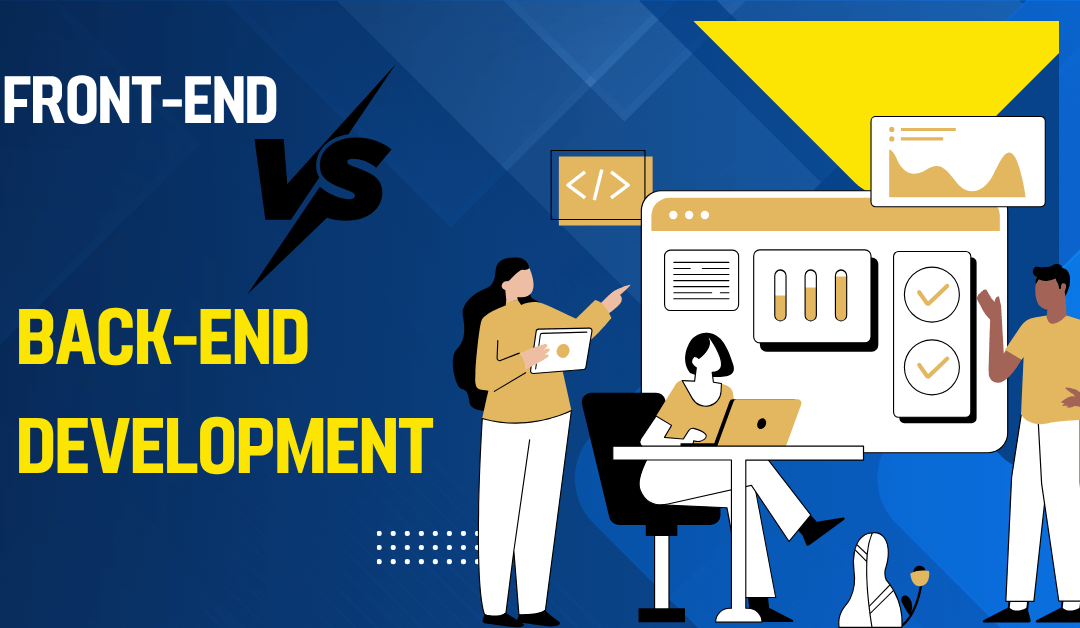If you have ever wondered how your favorite websites and apps work, you’ve likely heard the terms “front-end” and “back-end” development. They are the two halves of a whole, the yin and yang of the digital world. But what exactly is the difference?
In a nutshell:
- Front-end development is everything the user sees and interacts with directly in their web browser. It’s the visual design and interactive experience.
- Back-end development is the hidden logic and infrastructure that powers the website from the server. It’s the database, application logic, and architecture.
Let’s break this down in detail with clear examples.
The Perfect Analogy: A Restaurant
Imagine walking into a restaurant.
- The Front-End is the dining room. It’s the stylish decor, the comfortable chairs, the clean menu you read, and the friendly waiter who takes your order. This is your entire user experience.
- The Back-End is the kitchen. It’s where the chefs prepare your food, the inventory is managed, the recipes are stored, and the orders are coordinated. You never see it, but you’d never get your meal without it.
A website works the same way. The front-end is the presentation, and the back-end is the engine.
Diving Deep into Front-End Development (The “Client-Side”)
Front-end development, often called “client-side” development, is the art of creating the visual and interactive elements of a website that users engage with.
What Does a Front-End Developer Do?
A front-end developer’s primary mission is to ensure a website is visually compelling, intuitive to navigate, and fast across all devices—from a desktop monitor to a smartphone.
Their key responsibilities include:
- Translating UI/UX design wireframes into functional code.
- Building responsive websites that adapt to any screen size.
- Implementing animations and interactive elements.
- Optimizing page load times and performance.
- Ensuring web accessibility standards are met so everyone can use the site.
Core Technologies of the Front-End
The foundation of every website is built on three pillars:
- HTML (HyperText Markup Language): The skeleton. It defines the structure and content of the page, like headings, paragraphs, images, and buttons.
- Example: <button>Login Now</button> creates a clickable button on the page.
- CSS (Cascading Style Sheets): The skin and clothing. It controls the presentation, including layout, colors, fonts, and spacing.
- Example: button { background-color: blue; color: white; padding: 10px; } makes that button blue with white text and adds space around it.
- JavaScript: The brain and muscles. It adds interactivity, dynamic behavior, and complex features to a website.
- Example: JavaScript can make a dropdown menu appear when you hover over it, validate a form before you submit it, or dynamically update your Facebook feed without refreshing the page.
Popular Front-End Frameworks & Libraries: React, Angular, Vue.js, SASS, Bootstrap.
Unpacking Back-End Development (The “Server-Side”)
Back-end development, or “server-side” development, is all about what happens behind the scenes. It’s the logic, database interactions, and server management that users never see but rely on completely.
What Does a Back-End Developer Do?
A back-end developer focuses on the functionality, data, and security of a website. They build and maintain the technology that powers the front-end.
Their key responsibilities include:
- Writing the core application logic and architecture.
- Creating, managing, and querying databases.
- Building and integrating with APIs (Application Programming Interfaces).
- Implementing user authentication and authorization (logins, permissions).
- Ensuring data security and protection from attacks.
- Managing server infrastructure and deployment.
Core Components of the Back-End
- Server: The powerful computer that hosts the website and processes requests from users’ browsers.
- Application: The logic is written in a server-side language. This is the “brain” that decides what to do with a user’s request.
- Popular Languages: Python (with Django/Flask), JavaScript (with Node.js), PHP (with Laravel), Ruby (with Ruby on Rails), Java, C#.
- Database: The filing cabinet where all the website’s data is stored and organized.
- Example: User profiles, product information, blog posts, and transaction histories are all stored here.
- Popular Databases: MySQL, PostgreSQL (SQL databases), MongoDB (NoSQL database).
A Real-World Back-End Example:
When you search for “best running shoes” on an e-commerce site:
- Your search term is sent to the site’s server.
- A Python application (logic) receives your request.
- It queries the PostgreSQL database (storage) for all products tagged “running shoes.”
- The database sends the product data back to the application.
- The application structures the data and sends it back to your browser.
- The front-end (JavaScript) receives this data and displays the product list for you to see.
This entire process happens in milliseconds.
Front-End vs. Back-End: A Quick-Reference Table
|
Aspect |
Front-End Development |
Back-End Development |
|
Primary Focus |
User experience (UX), visual design, and interactivity. |
Logic, data management, security, and server infrastructure. |
|
Runs On |
The user’s web browser (client-side). |
The web server (server-side). |
|
Key Concern |
How the site looks and feels. |
How the site works and manages data. |
|
If it Fails… |
The site looks broken or isn’t interactive. |
The site won’t load, logins fail, or data is lost. |
|
Core Technologies |
HTML, CSS, JavaScript |
Python, Java, PHP, Node.js, Databases (SQL/NoSQL) |
The Bridge: Full-Stack Development
A Full-Stack Developer is a versatile expert proficient in both front-end and back-end technologies. They understand the entire web development process, from designing a user interface to configuring complex server databases. They are the “jack-of-all-trades” who can build a complete web application from the ground up.
Which Path is Right for You?
- Choose Front-End if you have an eye for design, enjoy creating visual experiences, and love seeing your work come to life instantly in the browser.
- Choose Back-End if you enjoy problem-solving, working with logic, data structures, and building the intricate systems that make applications function.
Both roles are in high demand and are equally critical to creating the seamless digital experiences we use every day. Understanding the difference is the first step to finding your place in the world of web development.

